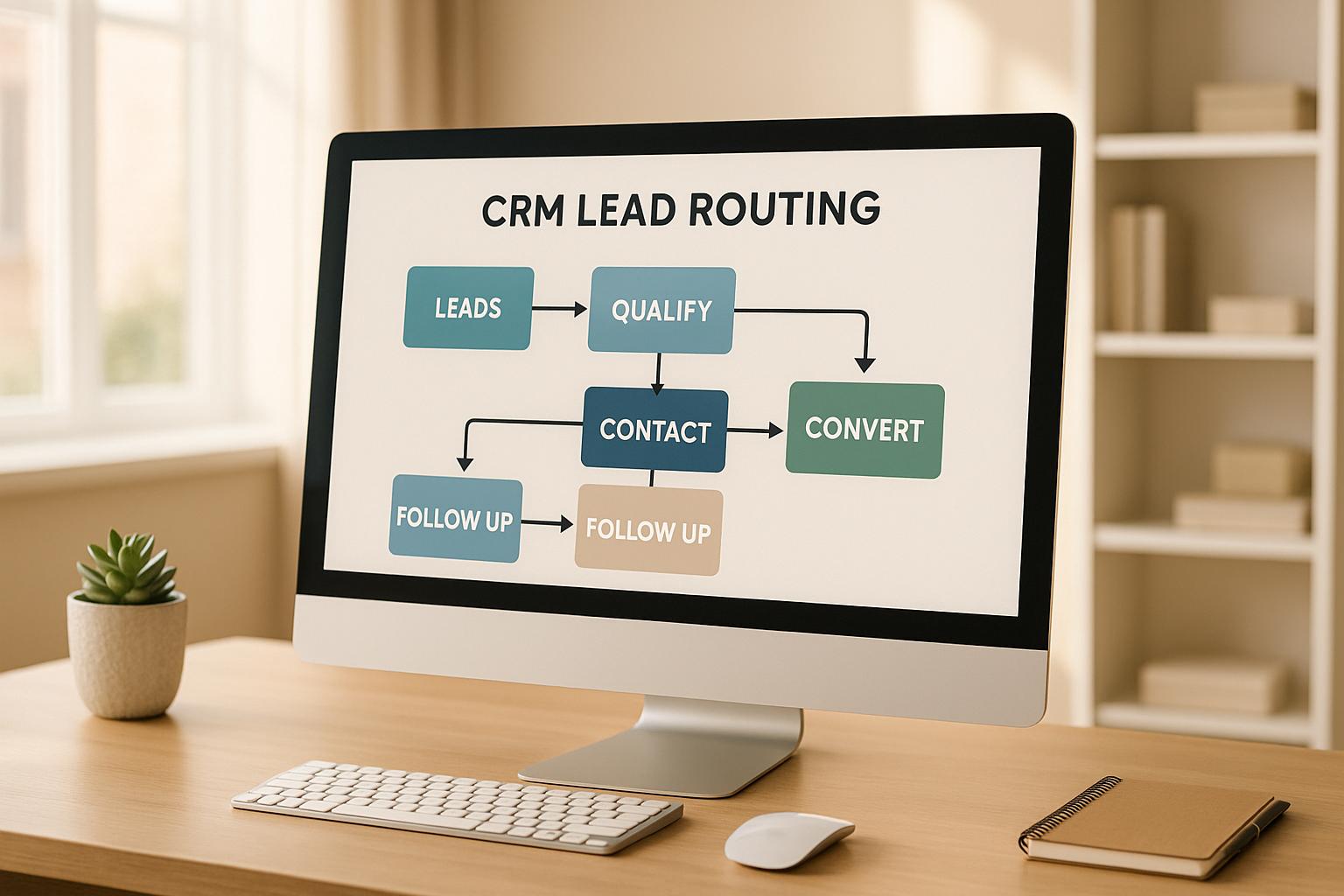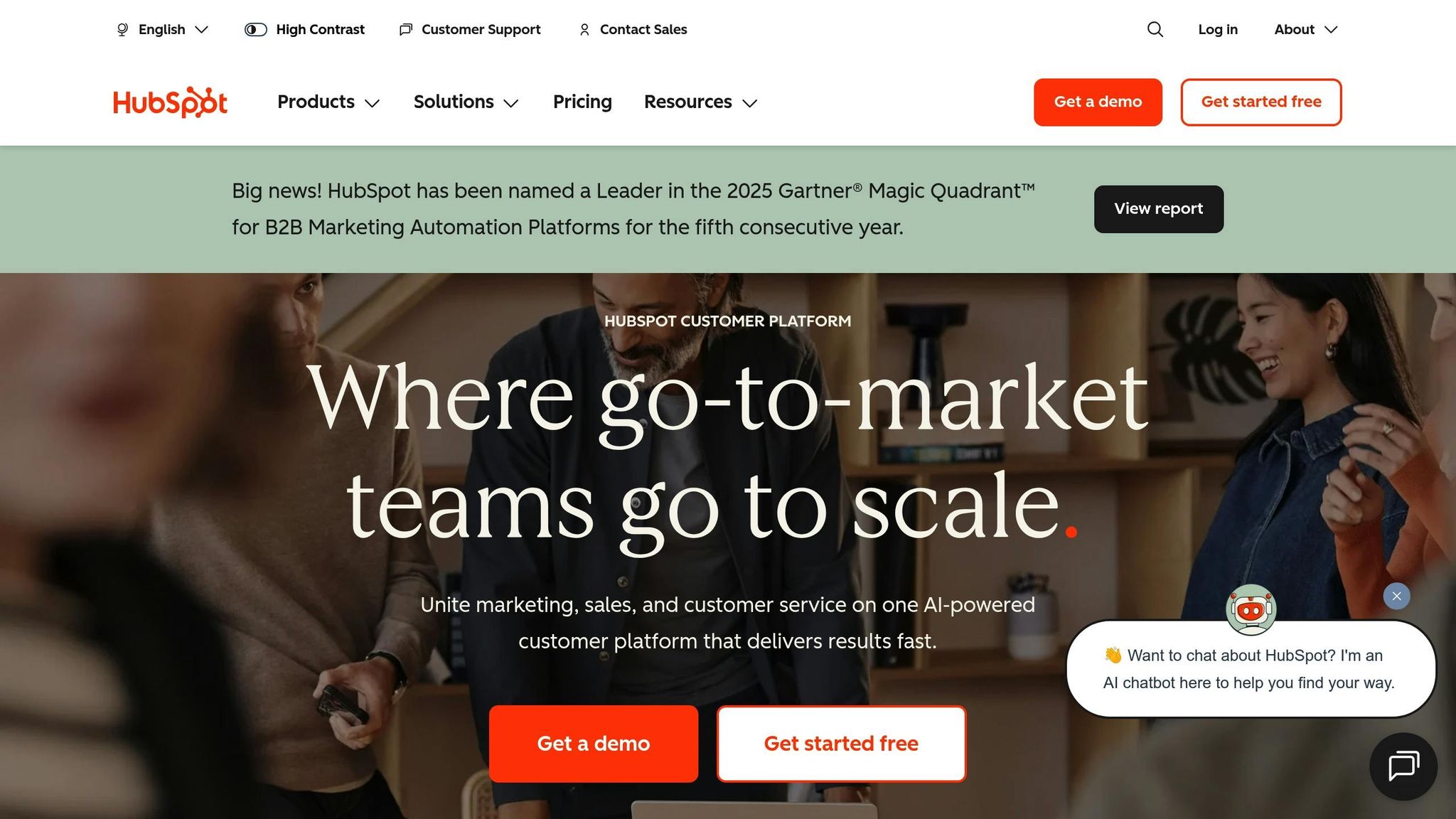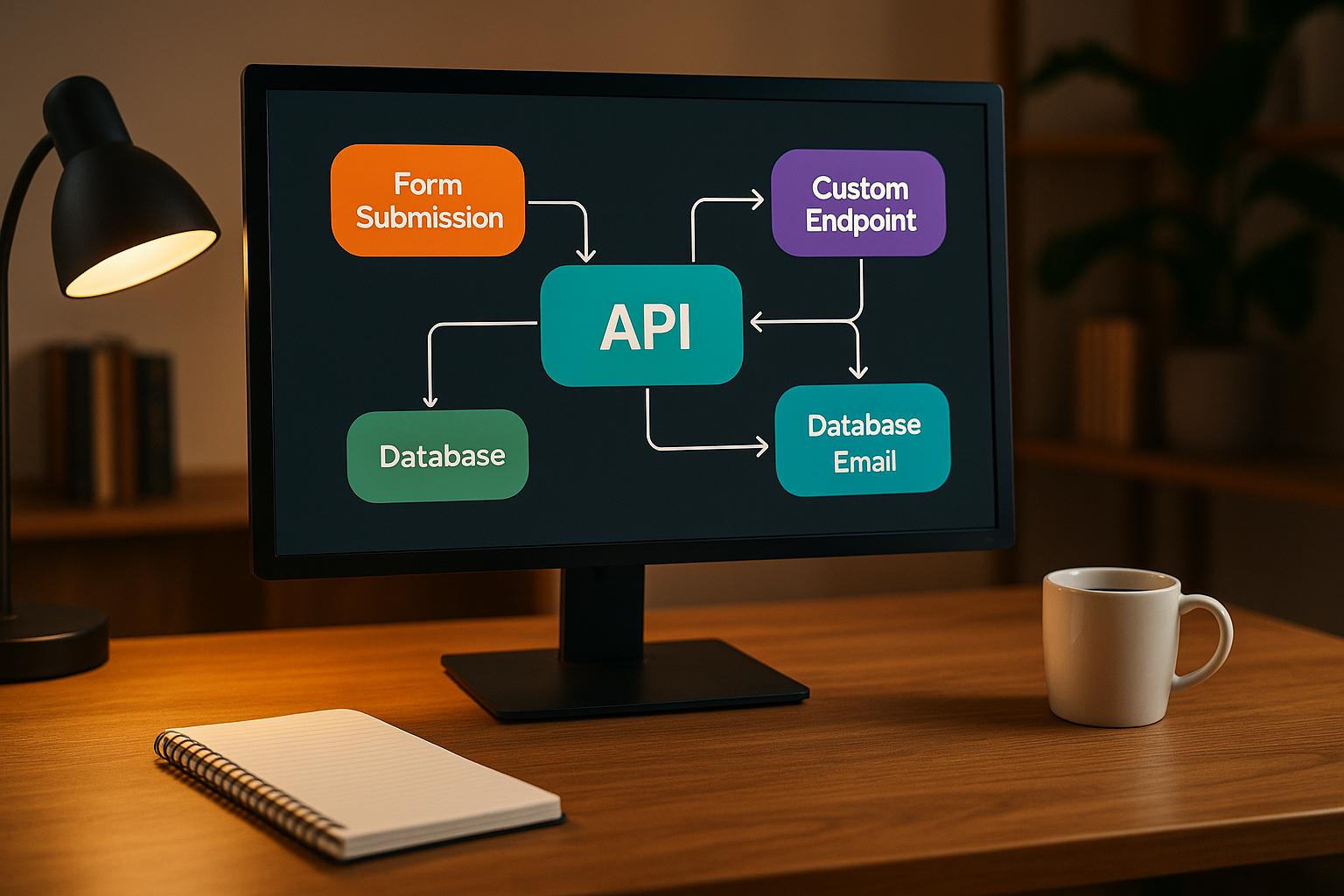Best Practices for CRM Lead Routing

CRM lead routing ensures leads are assigned to the right sales reps based on factors like location, lead source, company size, or product interest. This process improves response times, enhances lead management, and boosts conversion rates. Automated systems outperform manual methods by reducing delays and errors. Here's what you need to know:
- Use location-based routing: Assign leads to reps familiar with their region and time zone.
- Set clear routing rules: Define criteria like company size, industry, and product interest to ensure leads go to the right team.
- Leverage automation tools: Multi-step forms, conditional logic, and real-time data validation improve lead quality and routing accuracy.
- Prevent common issues: Manage lead overload, avoid duplicates, and maintain compliance with clear protocols and regular system checks.
How to Assign Leads by Territory in HubSpot | Strategic HubSpot Tutorial

Core Strategies for CRM Lead Routing
Getting lead routing right means crafting a plan that matches your sales team's strengths with your business goals. A well-thought-out system helps streamline processes and ensures leads are handled efficiently.
Location-Based Routing
One effective approach is assigning leads to sales reps who know the local market inside and out. Clearly define territories - whether by state lines, metro areas, or travel considerations. For example, a lead from California should naturally be directed to the West Coast team.
Time zones matter, too. Leads expect quick responses during their working hours. Automatically routing a California-based lead to a West Coast rep increases the chances of reaching them the same day.
It’s also important to distribute workloads evenly across territories. Cities like New York or Los Angeles often generate more leads compared to less populated areas. Using data enrichment tools to keep address information up to date can further refine your routing strategy.
Checklist for Setting Up CRM Lead Routing
Define Clear Routing Rules
The foundation of efficient lead routing lies in establishing clear guidelines for how leads should move through your organization. Start by identifying key lead attributes - like company size, industry, and product interest - that align with your business goals. These criteria will shape your routing process and ensure leads are directed to the right teams or representatives. By documenting these rules thoroughly, you can maintain consistency and streamline the routing process within your CRM system.
sbb-itb-5f36581
Improving Lead Routing with Form Builders and Automation
Advanced form tools take lead routing to the next level by simplifying lead capture and improving data quality, which are crucial for an efficient CRM. These tools combine smart data collection with seamless integration, making it easier to route leads accurately while cutting down on manual tasks that often slow down your sales process.
Use Multi-Step and Conditional Forms
Multi-step forms break the lead capture process into smaller, more manageable sections, making it easier for prospects to complete while gathering detailed information. Conditional logic further enhances this by customizing questions based on a prospect’s previous answers. For example, if a lead expresses interest in enterprise solutions, additional fields like company size or implementation timeline can dynamically appear.
Reform's multi-step forms and conditional routing features allow businesses to set up complex qualification workflows without the need for coding. You can use branching logic to automatically sort leads based on their responses, ensuring only qualified prospects enter your CRM.
To streamline the process, consider incorporating lead temperature indicators early in the form. Questions about budget, decision-making authority, and timeline can help prioritize routing even before the form is fully completed. Once detailed data is collected, verifying its accuracy in real time becomes critical.
Enable Real-Time Data Validation
Accurate data is essential for effective lead routing, and real-time validation ensures that only high-quality leads make it into your CRM. Features like email validation catch typos or fake addresses at the point of entry, while spam filters block automated submissions that could jam up your workflows.
Reform takes this a step further with tools that validate email addresses in real time, checking for proper formatting and domain validity before a prospect can submit the form. This ensures only legitimate leads reach your sales team.
Lead enrichment adds another layer of value by automatically supplementing the collected data with additional details, such as company size, industry, or location. For instance, when a lead enters their email address, enrichment tools can populate related fields, providing more context for your routing rules.
Other real-time validation features, like required field enforcement and phone number format checks, ensure your team receives complete and properly formatted information. This minimizes back-and-forth communication to fill in missing details, speeding up the qualification process.
CRM Integration
Once your data is validated, integrating your forms with your CRM ensures immediate and accurate lead routing. Direct integration automates lead assignment based on the rules you've set up in your CRM.
Reform integrates seamlessly with major CRM platforms, allowing you to map form fields directly to CRM properties. This triggers automated workflows as soon as a form is submitted, ensuring leads are routed without delay.
Real-time analytics from your form builder provide insights into lead flow, helping you identify bottlenecks or inefficiencies in your routing process. Metrics like form completion rates, lead source performance, and routing distribution can guide you in fine-tuning your approach.
For a more dynamic system, look for integrations that support bidirectional data flow. This means your CRM can update form behavior based on existing records. For example, if a known contact fills out a form, the system can route them differently than a first-time prospect, ensuring follow-ups are tailored to their history with your company.
Advanced integrations also enable trigger-based routing, activating specific workflows based on a lead's responses. This ensures leads are handled appropriately, whether they require immediate attention or a more standard follow-up process.
Common Challenges in Lead Routing
Even with well-thought-out routing strategies, problems like lead overload, duplicate data, and compliance issues can disrupt your system. Tackling these challenges head-on ensures your operations run smoothly and prevents valuable leads from slipping through the cracks.
Managing Lead Overload
An overflow of leads can create an imbalance - some reps might feel swamped, while others have little to do. To address this, consider capacity-based routing. Set clear limits on the number of active leads a rep can handle and use a weighted round-robin distribution. This method factors in each rep's availability and performance, ensuring a fairer distribution.
For example, experienced reps might handle a larger share of leads - say, 30% - while newer team members take 20%. If a lead remains unassigned because a primary rep is unavailable, time-based reassignment kicks in to keep things moving.
Keep an eye on your lead-to-rep ratios by reviewing them weekly. If one person consistently gets more leads than others, adjust your routing rules or reallocate leads to even things out. Balancing the workload is crucial, but maintaining clean and accurate data is just as important.
Avoiding Data Duplication
Duplicate leads can wreak havoc on your system, leading to wasted time and confusion when multiple reps contact the same prospect. This often happens when leads enter through different channels or when your data matching rules aren’t strict enough.
Start with email-based deduplication, which flags leads with identical email addresses. Since some prospects use multiple emails, complement this with matching based on phone numbers and company names. Implement fuzzy matching rules to catch slight variations in data entries. For instance, CRMs often allow you to set a similarity threshold - typically between 80% and 90% - to identify potential duplicates.
Use source tracking to pinpoint where duplicates originate. If you notice a pattern, like duplicates from webinar registrations, check whether your form integrations are causing the issue. Tools with real-time validation can help by checking for existing records before creating new ones.
For duplicates that do slip through, establish a merge protocol. Decide which rep gets to keep the lead based on factors like who contacted them first, the strength of the relationship, or the deal stage. Document this process so your team can handle duplicates consistently.
Finally, schedule regular database cleanups - monthly reviews are a good starting point. Focus on high-volume sources, such as trade shows or content downloads, to ensure your records remain accurate and streamlined.
Ensuring Flexibility and Compliance
Beyond managing volume and data quality, your system needs to be adaptable and compliant to handle changes effectively. Rigid systems struggle when reps are unavailable or when compliance requirements shift. To avoid this, set up backup routing that redirects leads based on calendars, and use role-based permissions to control who can make changes to routing rules.
For international leads, geographic compliance is key. For example, GDPR mandates explicit consent when processing data from EU residents. Certain industries may also have specific routing requirements. Build compliance checks into your workflows to ensure leads from regulated regions are handled appropriately.
Adaptability is also critical during busy periods. Use seasonal adjustments to temporarily modify rules, such as expanding territories or tweaking lead distribution during peak times. Create rule templates for scenarios like holiday coverage or product launches so you can quickly switch configurations as needed.
Lastly, test your system’s failsafe mechanisms regularly. Simulate disruptions, such as a top-performing rep leaving or a sudden influx of leads from a successful campaign. These tests help you find and fix gaps in your routing logic before they become real problems.
Key Takeaways
Getting CRM lead routing right boils down to three main pillars: automation, ongoing refinement, and smart integration. Here's a compelling stat: companies that respond to leads within five minutes are 21 times more likely to qualify them compared to those taking 30 minutes or longer. That’s why automated routing isn’t just helpful - it’s necessary to stay ahead.
Start by setting clear and measurable routing rules. Consider factors like location, lead score, and product interest. For example, in 2023, a SaaS company using Salesforce implemented automated lead routing based on territory and lead score. The result? Faster response times and higher conversions. Real-time analytics then fine-tuned the process further.
Automation does more than just speed things up - it reduces errors and ensures fair distribution among your sales team. One B2B services firm adopted round-robin distribution and AI-driven routing in HubSpot. The impact? A 22% jump in sales rep productivity and a 19% boost in customer satisfaction within a single quarter. However, even the best routing system can falter if the incoming leads aren’t high quality.
That’s why the quality of your leads matters just as much as the routing process itself. Tools like Reform help capture enriched, high-quality leads through multi-step forms with real-time validation and conditional routing. When these clean, accurate leads enter your CRM, your routing rules can work effectively from the start. Combining precise data capture with CRM automation ensures your process runs smoothly.
To keep things on track, monitor key metrics like lead response time, conversion rates, and workload distribution. Regular reviews are crucial - schedule weekly checks on lead-to-rep ratios and monthly database cleanups to keep your system running efficiently. And don’t forget: routing strategies need to adapt during busy periods, like product launches or seasonal peaks.
The most successful teams understand that lead routing is never a "set it and forget it" task. It’s an ongoing process. Regular testing, tweaking rules, and updating integrations ensure your system evolves alongside your team and market demands. By embracing this continuous improvement mindset, you’ll set your team up for long-term success.
FAQs
What are the best ways to align CRM lead routing rules with my business goals?
To make sure your CRM lead routing rules align with your business goals, start by setting clear and specific criteria that match your priorities. These might include factors like geographic location, industry type, or specific product interests. Take advantage of automation tools in your CRM to assign leads to the right sales reps based on these criteria. This approach helps ensure quicker response times and can boost your conversion rates.
It's also important to regularly revisit and fine-tune your lead routing strategy. As your business goals or market conditions shift, updating these rules keeps your process effective and aligned with your objectives. Aim for a system that prioritizes simplicity and accuracy to improve both efficiency and the quality of your leads.
What are common mistakes in CRM lead routing, and how can you avoid them?
Some frequent missteps in CRM lead routing include dealing with outdated or incorrect lead data, setting up confusing or overly complicated routing rules, and relying on manual methods that can bog down the process. These challenges often lead to misplaced leads, unnecessary delays, and missed chances to connect with potential customers.
To steer clear of these issues, prioritize keeping your lead data accurate and current, create clear and easy-to-follow routing rules, and take advantage of automation tools to make the process more efficient. A streamlined and precise system not only ensures faster follow-ups but also boosts lead distribution and helps improve conversion rates.
How does real-time data validation improve lead quality in a CRM system?
Real-time data validation checks contact details like email addresses and phone numbers the moment they're entered. This helps catch errors or incomplete information right away, keeping your CRM system free of inaccuracies.
With a clean and precise database, your sales and marketing teams can concentrate on quality leads, work more efficiently, and avoid wasting time on bad data. The result? Streamlined efforts and a better chance of turning prospects into customers.
Related Blog Posts
Get new content delivered straight to your inbox

The Response
Updates on the Reform platform, insights on optimizing conversion rates, and tips to craft forms that convert.
Drive real results with form optimizations
Tested across hundreds of experiments, our strategies deliver a 215% lift in qualified leads for B2B and SaaS companies.





